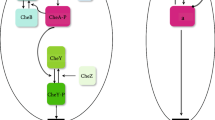Abstract
We consider the dynamics of chemotaxis in the model bacterium Escherichia coli. We analyze both its molecular mechanisms and the functional causes governing the evolution of the observed behaviors. We review molecular models of the transduction network controlling the bacterial chemotaxis in response to chemoattractant binding to the receptors. In particular, recent progress stimulated by FRET experiments is presented for statistical physics allosteric models. The response function to a pulse of chemoattractant is expressed in terms of microscopic parameters of the allosteric models. The functional causes for the shape of the response function, as measured in experimental tethering assay, are then investigated. A hydrodynamic equation, valid for space-time scales larger than the microscopic running length and time, is derived for the position of a swimming bacterium. It is then shown how optimization over the microscopic parameters of the response function yields the curve observed experimentally. In particular, the observed property of adaptation to the background level of aspartate emerges as being produced by fluctuations in the space-time chemoattractant profiles sensed by bacteria along their trajectories. This functional cause is distinct from arguments based on the extension of the dynamical range. Future directions and experiments to probe the adaptation of E. coli chemotaxis to the environmental conditions and its response to realistic space-time chemoattractant stimuli are finally discussed.
Similar content being viewed by others
References
Berg, H.C.: E. coli in Motion, Springer, New York (2003)
Vergassola, M., Villermaux, E., Shraiman, B.I.: Infotaxis: searching without gradients. Nature 445, 406–409 (2007)
Adler, J., Templeton, B.: The effect of environmental conditions of Escherichia coli. J. Gen. Microbiol. 46, 175–184 (1967)
Staropoli, F., Alon, U.: Computerized analysis of chemotaxis at different stages of bacterial growth. Biophys. J. 78, 513–519 (2000)
Wei, Y., Wang, X., Liu, J., Nemenman, I., Singh, A.H., Weiss, H., Levin, B.R.: The population dynamics of bacteria in physically structured habitats and the adaptive virtue of random motility. Proc. Natl. Acad. Sci. USA 108, 4047–4052 (2011)
Tu, Y., Shimizu, T.S., Berg, H.C.: Modeling the chemotactic response of Escherichia coli to time-varying stimuli. Proc. Natl. Acad. Sci. USA 105, 14855–14860 (2008)
Shimizu, T.S., Tu, Y., Berg, H.C.: A modular gradient-sensing network for chemotaxis in Escherichia coli revealed by responses to time-varying stimuli. Mol. Syst. Biol. 6, 382 (2010)
Celani, A., Vergassola, M.: Bacterial strategies for chemotaxis response. Proc. Natl. Acad. Sci. USA 107, 1391–1396 (2010)
Vladimirov, N., Sourjik, V.: Chemotaxis: how bacteria use memory. Biol. Chem. 390, 1097–1104 (2009)
Cluzel, P., Surette, M., Leibler, S.: An ultrasensitive bacterial motor revealed by monitoring signaling proteins in single cells. Science 287, 1652–1655 (2000)
Bai, F., Branch, R.W., Nicolau, D.V., Pilizota Jr., T., Steel, B.C., Maini, P.K., Berry, R.M.: Conformational spread as a mechanism for cooperativity in the bacterial flagellar switch. Science 327, 685–689 (2010)
Bray, D., Duke, T.A.J.: Conformational spread: the propagation of allosteric states in large multiprotein complexes. Annu. Rev. Biophys. Biomol. Struct. 33, 53–73 (2004)
Barkai, N., Leibler, S.: Robustness in simple biochemical networks. Nature 387, 913–917 (1997)
Li, M., Hazelbauer, G.L.: Adaptational assistance in clusters of bacterial chemoreceptors. Mol. Microbiol. 56, 1617–1626 (2005)
Mello, B.A., Tu, Y.: An allosteric model for heterogeneous receptor complexes: understanding bacterial chemotaxis responses to multiple stimuli. Proc. Natl. Acad. Sci. USA 102, 17354–17359 (2005)
Keymer, J.E., Endres, R.G., Skoge, M., Meir, Y., Wingreen, N.S.: Chemosensing in Escherichia coli: two regimes of two-state receptors. Proc. Natl. Acad. Sci. USA 103, 1786–1791 (2006)
Hansen, C.H., Endres, R.G., Wingreen, N.S.: Chemotaxis in Escherichia coli: a molecular model for robust precise adaptation. PLoS Comput. Biol. 4, e1 (2008)
Vladimirov, N., Løovdok, L., Lebiedz, D., Sourjik, V.: Dependence of bacterial chemotaxis on gradient shape and adaptation rate. PLoS Comput. Biol. 4, e1000242 (2008)
Emonet, T., Cluzel, P.: Relationship between cellular response and behavioral variability in bacterial chemotaxis. Proc. Natl. Acad. Sci. USA 105, 3304–3309 (2008)
Jiang, L., Ouyang, Q., Tu, Y.: A mechanism for precision-sensing via a gradient-sensing pathway: a model of Escherichia coli thermotaxis. Biophys. J. 97, 74–82 (2009)
Vladimirov, N., Lebiedz, D., Sourjik, V.: Predicted auxiliary navigation mechanism of peritrichously flagellated chemotactic bacteria. PLoS Comput. Biol. 6, e1000717 (2010)
Segall, J.E., Block, S.M., Berg, H.C.: Temporal comparisons in bacterial chemotaxis. Proc. Natl. Acad. Sci. USA 83, 8987–8991 (1986)
Bensoussan, A., Lions, J.-L., Papanicolau, G.: Asymptotic Analysis for Periodic Structures. North-Holland, Amsterdam (1978)
de Gennes, P.G.: Chemotaxis: the role of internal delays. Eur. Biophys. J. 33, 691–693 (2004)
Attneave, F.: Informational aspects of visual perception. Psychol. Rev. 61, 183–193 (1954)
Barlow, H.B.: Possible principles underlying the transformation of sensory messages. In: Sensory Communication, pp. 217–234. MIT Press, Cambridge (1961)
Nemenman, I.: Information theory and adaptation. In: Wall, M.E. (ed.) Quantitative Biology: From Molecular to Cellular Systems. Taylor & Francis, London (2011)
Laughlin, S.B.: Form and function in retinal processing. Trends Neurosci. 10, 478–483 (1987)
Brenner, N., Bialek, W., de Ruyter van Steveninck, R.: Adaptive rescaling optimizes information transmission. Neuron 26, 695–702 (2000)
Kalinin, Y.V., Jiang, L., Tu, Y., Wu, M.: Logarithmic sensing in Escherichia coli bacterial chemotaxis. Biophys. J. 96, 2439–2448 (2009)
Salman, H., Libchaber, A.: A concentration-dependent switch in the bacterial response to temperature. Nat. Cell Biol. 9, 1098–1100 (2007)
Skoge, M., Endres, R.G., Wingreen, N.S.: Receptor-receptor coupling in bacterial chemotaxis: evidence for strongly-coupled clusters. Biophys. J. 90, 4317–4326 (2006)
Greenfield, D., et al.: Self-organization of the Escherichia coli chemotaxis network imaged with super-resolution light microscopy. PLoS Biol. 16, e1000137 (2009)
Manley, S., Gillette, J.M., Patterson, G.H., Shroff, H., Hess, H.F., Betzig, E., Lippincott-Schwartz, J.: High-density mapping of single-molecule trajectories with photoactivated localization microscopy. Nat. Methods 5, 155–157 (2008)
Berg, H.C., Brown, D.A.: Chemotaxis in Escherichia coli analysed by three-dimensional tracking. Nature 239, 500–504 (1972)
Author information
Authors and Affiliations
Corresponding author
Rights and permissions
About this article
Cite this article
Celani, A., Shimizu, T.S. & Vergassola, M. Molecular and Functional Aspects of Bacterial Chemotaxis. J Stat Phys 144, 219–240 (2011). https://doi.org/10.1007/s10955-011-0251-6
Received:
Accepted:
Published:
Issue Date:
DOI: https://doi.org/10.1007/s10955-011-0251-6




